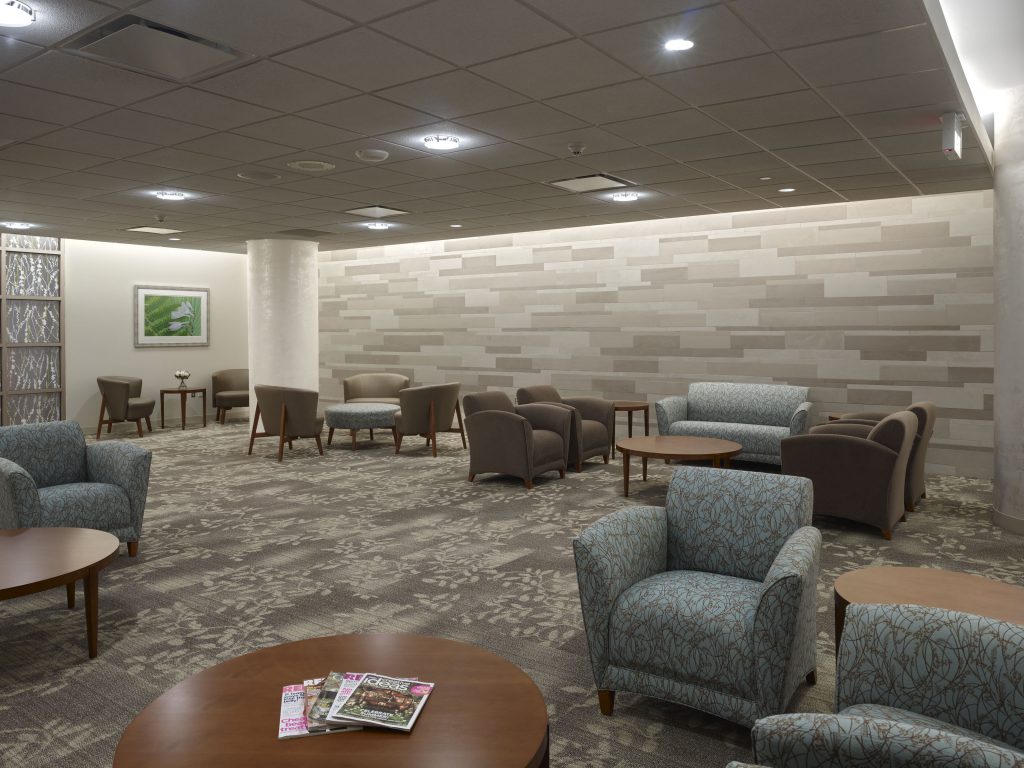From hospitals and maternity wards to nursing homes, healthcare facilities are in general locations where healthcare is provided. As research continues to bring forth new ideas and techniques to promote healing, one idea specifically aims to create sustainable medical facilities that improve the health of the patients as well as the health of the environment.
The LEED for Healthcare Green Building Rating System is an arrangement of guidelines and performance standards for certifying health care facilities. The goal is to promote clean, healthy, affordable, durable, and environmentally friendly practices into the construction and design of the building. When it comes to materials, flooring may seem like a minor factor in relation to the the facility as a whole. However, with its large surface area and high amounts of foot traffic, choosing the right type of flooring and flooring materials is quite important. Of the seven topics that LEED for Healthcare focuses on, here are four that can be directly attributed to flooring within a healthcare facility.

Photo Credit: Spectra Contract Flooring.
Materials and Resources

When it comes to materials and resources, LEED wants facilities to consider materials that will have less impact on the environment by using rapidly renewable content such as green flooring. This type of flooring is sustainably harvested from environmentally-friendly, recyclable and natural sources. Options to consider include:
Engineered Hardwood
When choosing hardwood flooring, it is important to understand the source of the wood used and how it is processed into flooring. In conventional solid hardwood, each board is milled from a single piece of timber. However, that same piece of timber can produce multiple boards of engineered hardwood.
Cork
Offering warmth, comfort, quietness, and easy maintenance, cork is a smart, environmentally friendly solution. Being 100 percent sustainable, cork is recognized by LEED certification for the use of low-emitting materials, recyclable content, and rapidly renewable materials.
Carpet Tiles
Many manufacturers are now producing carpet tiles made from recycled material and adhesives that are non-toxic. New CRI and EPA standards have strictly reduced the amount of VOC’s that carpeting can emit. Therefore, choosing recycled carpeting can lead to better indoor air quality and enhanced durability.

Photo Credit: Spectra Contract Flooring.
Epoxy Resin
Protectant against staining, mold, mildew and foul odors, epoxy resin has become a very popular flooring option amongst many healthcare facilities. Resin is also one of the longest lasting flooring options available and can contribute to LEED credits by containing recyclable content and low emitting material.
Regional Priority
Facilities can also acquire credits by obtaining flooring that has been locally extracted, harvested or recovered, as well as manufactured within 500 miles of the site. Finding locally sourced flooring can be difficult and time consuming. However, even if only a fraction of a product or material is locally extracted/harvested/recovered and manufactured, then that percentage (by weight) can still contribute to its regional value. The goal is to cut down on long transportation of materials, which would lessen hazardous pollutants and greenhouse gases.
A database of Regional Priority credits and their geographic applicability is available on the USGBC website, www.usgbc.org
Innovation & Design
 Innovation and design targets the utilization of new ideas and techniques for green design and construction. When it comes to flooring, there have been many innovative ideas for lowering volatile organic compounds (VOCs), and other high emitting adhesives. Companies such as Interface and Shaw have broken ground on techniques to achieve this goal through TacTiles and LokDots.
Innovation and design targets the utilization of new ideas and techniques for green design and construction. When it comes to flooring, there have been many innovative ideas for lowering volatile organic compounds (VOCs), and other high emitting adhesives. Companies such as Interface and Shaw have broken ground on techniques to achieve this goal through TacTiles and LokDots.
TacTiles by Interface is a unique and innovative installation system. Instead of using wet adhesives or heavy buckets of glue, TacTiles securely connect carpet tiles to one another, forming a floor that “floats.” This process allows for fast, easy, and clean installation and non-slip, slide, or buckling durability. This unique installation system has virtually no volatile organic compounds (VOCs) and also meets LEED requirements for reduction of material, low-VOC material and innovation and design.
LokDots by Shaw is also a unique installation system that does not involve any glue or wet adhesives. The dots are loaded into a dispenser and are placed onto the back of the carpet tile (3 dots in the center and 3 dots per corner). LokDots use up to 97% less adhesive material than other wet adhesives and can also contribute to LEED certification by meeting the requirements for reduction of material, low-VOC material, and innovation and design.
Indoor Environmental Quality
 Healthcare facilities are unique work environments compared to other job sites. Many healthcare facilities, such as hospitals, nursing homes, and maternity units provide 24/7 service. Therefore, patients and staff cannot be removed from the facility during construction or renovation work. Patients with weak immune systems can be susceptible to breathing problems or sickness caused by airborne particles during the demolition stage. During flooring renovation, construction teams should consider:
Healthcare facilities are unique work environments compared to other job sites. Many healthcare facilities, such as hospitals, nursing homes, and maternity units provide 24/7 service. Therefore, patients and staff cannot be removed from the facility during construction or renovation work. Patients with weak immune systems can be susceptible to breathing problems or sickness caused by airborne particles during the demolition stage. During flooring renovation, construction teams should consider:
- Containing flooring waste in tightly covered containers before transport.
- Covering transport receptacles or carts.
- Vacuuming work area with HEPA-filtered vacuum.
- Wet mopping affected area with disinfectant.
Air quality is important to every facility, yet it may be even more important when it comes to a healthcare facility. In a place designed to promote healing, air quality issues should to be non-existent.
About the author:
Mitchell Bryant is the communications specialist at Spectra Contract Flooring, the largest commercial flooring contractor in the U.S.
3 thoughts on “LEED for Healthcare: Flooring Tips, Techniques and Materials”
Comments are closed.






Interesting blog ….good information very helpful to readers …thanks for sharing keep posting..!
For More Information industrial flooring contractors
Nice Blog, thanks for sharing. For more services visit
industrial flooring contractors
Good work, keep it up